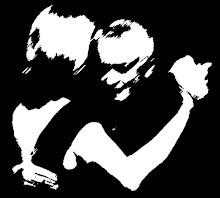“I want to dance tango” is heard often from newcomers, and “I want to dance tango well” from those already dancing. My (no-nonsense) response: “you’ll need to work hard on your axis, posture, embrace, and tango walk before anything else can happen."
So why the constant reminders about the embrace in class? - in fact, some will say tango IS the embrace. Well, the embrace is the physical point of connection between the man and the woman. It is the channel of communication as the man suggests (leads), the woman responds (follows) and the man follows the woman. Hence, they dance together, rather than two separate entities; communication - some might say energy – flows back & forth between the two.
So what can interrupt the flow? From a physical point of view, one of the main sources of trouble is the man’s left and the woman’s right arms. If the man pushes & pulls, his partner is taken off her axis and the lead becomes confused. If her right arm flexes, she’ll be ‘absorbing’ the lead rather than her body moving with it. After all, the lead comes from the man’s upper torso, to be responded to by the woman’s body. Nothing should get in the way of that – including cognitive pursuits like trying to remember learned patterns, studying the man’s chest for movement, or peeking at each other’s feet for cues. We need to be fully present for our partner and the music.
The upper torso – the ‘frame’ – needs to be strong and yet relaxed: tense muscles won’t give & receive subtle signals. The man’s embrace needs to be able to communicate clearly where he would like his partner to go; the woman’s embrace needs to be confident – a presence that the man can feel. Yet it’s light and doesn’t fight back or lean on him.
Getting the embrace right can be frustrating at first. But finding the right balance between strength and relaxation, assertiveness and responsiveness enables us to be equal contributors in our different roles. It allows us to give rather than impose. That’s when it feels like we’re dancing as one, rather than struggling with the other.
For an amusing and informative look at a range of embraces, take a look at a wonderful series of photographs and captions on tangocherie’s website. There’s also an interesting series of comments about the effects of some of the embraces on the writers.
Bob
Salon Canning has reopened for milongas
5 days ago
